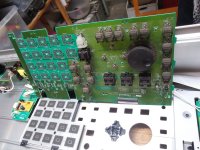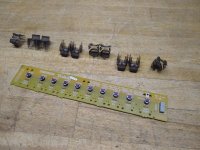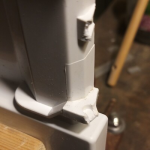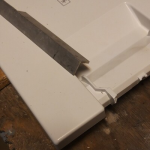Hi NareshBrd,
I have to agree with you. This "throw it away" thinking is new to me and against how I grew up. We were trained to repair and even improve where we could. I find it very wasteful and a real shame to throw something away. It should be illegal to sell goods designed to fail since we know how to make things that last a very long time.
Business and a quick buck drives this trend. Greed in other words.
I have to agree with you. This "throw it away" thinking is new to me and against how I grew up. We were trained to repair and even improve where we could. I find it very wasteful and a real shame to throw something away. It should be illegal to sell goods designed to fail since we know how to make things that last a very long time.
Business and a quick buck drives this trend. Greed in other words.
I repaired this keyboard from a local musician.
The Roland Fantom 8X is a massive beast!
Two pushbutton did not work at all.
Replacements are available at Pollin with an affordable price tag (0.03€/each).
Once disassembled, I replaced them all (ca 30), did some cleaning and voilá -
all is fine again.
The Roland Fantom 8X is a massive beast!
Two pushbutton did not work at all.
Replacements are available at Pollin with an affordable price tag (0.03€/each).
Once disassembled, I replaced them all (ca 30), did some cleaning and voilá -
all is fine again.
Attachments
Last edited:
Local musician's Peavey VK 100. It has rectified heater feeding all the tubes in strange series/parallel combination and originally has 1n4003 diodes in the place. Fused by 3AT fuse. Strange amp indeed. Using 6A diodes is an overkill, but they're cheap and were on hand. Just crossing fingers that fuse will act in a case of short.
Attachments
Fixed a microwave. The fault showed up when I was cleaning the cook chamber: running a sponge on its ceiling rebooted the display with accompanying beeps, although without the magnetron coming on. Most likely a bad connection in the AC or some such, so I peeled the cover from the thing and started tapping connectors with the butt end of a screwdriver. Eventually a pair of wires showed up where touching them gently would provoke the fault, and they just happened to lead to something looking like a thermal switch attached to the cook ceiling. Unplugged the unit, yanked the switch, lo & behold one faston tab had a rivet wobblier than a department store Santa after a long day at the office.
Ordered a replacement with the same part number, slapped it in, and voilà, problem solved.
This wouldn't have been quite so dramatic were it not for the apes who installed the microwave over the stove five years ago managing to cross-thread one of the two mounting screws (the back was supported by a French cleat arrangement). Vise-grips were needed to shift that one, which of course was a weird thread, not 1/4-20 as God and Man intended but the unholy 1/4-28. Also, just to make things extra special the cover had two anti-tamper Torx (removed via pliers). Why, General Electric, why? McMaster-Carr to the rescue with replacements for the Cthulhu screw, along with a similarly cursed tap to heal the unit's mounting nut from its mutilated state, and a bit to emplace the annoying security-through-obscurity screws.
Fortunately I'd ordered the hardware at the same time as the microswitch so after a few short Anglo-Saxon words the thing was sewn up, with my neighbour giving a hand to hoist it into place.
The fault wasn't the tedious bit, matter of fact fixing it was kind of restful, but all the nonsense around it, oy gevalt.
Ordered a replacement with the same part number, slapped it in, and voilà, problem solved.
This wouldn't have been quite so dramatic were it not for the apes who installed the microwave over the stove five years ago managing to cross-thread one of the two mounting screws (the back was supported by a French cleat arrangement). Vise-grips were needed to shift that one, which of course was a weird thread, not 1/4-20 as God and Man intended but the unholy 1/4-28. Also, just to make things extra special the cover had two anti-tamper Torx (removed via pliers). Why, General Electric, why? McMaster-Carr to the rescue with replacements for the Cthulhu screw, along with a similarly cursed tap to heal the unit's mounting nut from its mutilated state, and a bit to emplace the annoying security-through-obscurity screws.
Fortunately I'd ordered the hardware at the same time as the microswitch so after a few short Anglo-Saxon words the thing was sewn up, with my neighbour giving a hand to hoist it into place.
The fault wasn't the tedious bit, matter of fact fixing it was kind of restful, but all the nonsense around it, oy gevalt.
The door of the freezer compartment of my fridge. This is small tabletop model fridge. It has a separate *** freezer compartment. The door of this compartment has a gasket which is compressed when the door closes so as to seal this compartment really well. That is a good design as such. Only those blockhead appliance manufacturers do not understand that you cannot use plastic parts if they are under continuous stress forces. Eventually that breaks. And that happened here. Both one door hinge pin and the lock hinge broke off. So the door could not be properly closed. Water vapor entering the freezer compartment, temperature increase, etc.





First glued the hinge back in place



Then took a bicycle spoke and used it as rebar reinforcement for
the hinge. Filled the hinge with hot glue to keep everything in place.
Since the hot glue does not take up any forces this technique does
not qualify for being a life hack. Besides, no PET bottle is used.

Start of the reconstruction of the door lock hinge







Removal of the broken material


Perfect now
When I finished this project I discovered I could purchase a complete new door for € 100 or so. The price of a complete fridge is € 300-400. So no, I am not adhering to the designed-to-fail philosophy.
First glued the hinge back in place
Then took a bicycle spoke and used it as rebar reinforcement for
the hinge. Filled the hinge with hot glue to keep everything in place.
Since the hot glue does not take up any forces this technique does
not qualify for being a life hack. Besides, no PET bottle is used.
Start of the reconstruction of the door lock hinge
Removal of the broken material
Perfect now
When I finished this project I discovered I could purchase a complete new door for € 100 or so. The price of a complete fridge is € 300-400. So no, I am not adhering to the designed-to-fail philosophy.
Attachments
You could not get a hinge for about 10 Euro from an on line furniture parts seller?
That could have compensated for the stressed plastic part.
Nice effort, however.
Next time, get fiber mesh (not the dangerous random fiberglass choppings), sold for shoe repair and so on, or woven fiberglass mosquito net.
Use that to reinforce epoxy / glue, it works.
That could have compensated for the stressed plastic part.
Nice effort, however.
Next time, get fiber mesh (not the dangerous random fiberglass choppings), sold for shoe repair and so on, or woven fiberglass mosquito net.
Use that to reinforce epoxy / glue, it works.
Last edited:
Sure, I build furniture and I have hinges in all sizes. I had considered it but then the problem is how to attach the hinge. The only way had been self tapping screws in the fridge wall and I did not exactly like that.You could not get a hinge for about 10 Euro from an on line furniture parts seller?
Fiberglass could have been an option if I had sufficient space to build up a layer, but there was not. That might not be completely obvious from the pictures, there was no space neither on the inside, nor on the outside of freezer door.
Heck, I repaired a coffee bean grinder. The triac anode lead snapped due to vibration, found a bad capacitor as well. Fixed it and secured the triac. Next time I expect the brushes to be shot.
I've just repaired a Moulinex blender we bought many years ago (Made in France). Son's GF was a bartender during study and makes cocktails. We got the blender out and it had a crack in the plastic base and was leaking. I figured it was the sintered bronze bush that was probably a little too large for the plastic, and over time, had over stressed the plastic which had split (there was no corrosion).
She had to make the Xmas cocktails in a food processor. Whey-heyy, who cares? Hic...
Boxing day, I pressed the bush out and clamped it with two nuts on a threaded rod, then into the drill press. Using a file, I turned down the diameter until it didn't open up the crack in the plastic when pressed back in. Then, using a soldering iron (with a steel homemade plastic welding tip fitted) I closed up the gap in the plastic by melting and spreading. THEN, I pressed in the now just-loose bush, coated in epoxy.
24 hours later, it seems to be OK...mango dacquiris, anyone? Hic...
Only worth posting due to the safety issue, in the unlikely event that anyone in the UK is still using an NAD C420 RDS tuner. Mine was crackling for 5-10 seconds after switching on, and then working fine. I thought 'bound to be one or more caps expiring; beyond economic (commercial) repair; so why not have a look?' The main pcb had two groups of caps with brown gunge at the bases, so out it came and said caps were removed. That was the point at which I discovered that the 'gunge' was dried-out brown glue, (I hadn't realised that even the small ones are sometimes glued) and more usefully noticed that the mains plug was crumbling to bits. It consisted of a two-pin (continental?) plug inserted into a three-pin UK housing, and it was the housing that was falling apart. Next time I unplug anything suspect I'll take precautions and pay more attention. A new conventional plug, cleaned circuit board and five new caps later I have a functioning tuner with no crackles, but would be happier if I knew exactly where the original fault was. Knowledge gained: very little, except - take nothing for granted and don't pre-judge before you even have the lid off. And of course, if it's made in China always check electrical safety, and if it's made in China a long time ago, check it twice. Very carefully.
Moulinex is long gone, wound up...so you were lucky that it worked.
Parts not available...
Crackling could be sparks in mains wire being picked up by tuner.
Or glue interactions / bad capacitors.
Time out stability would mean a capaitor or leaky semiconductor, anyway problem solved.
I hope you put a heavier duty (higher current rated) mains cord.
Parts not available...
Crackling could be sparks in mains wire being picked up by tuner.
Or glue interactions / bad capacitors.
Time out stability would mean a capaitor or leaky semiconductor, anyway problem solved.
I hope you put a heavier duty (higher current rated) mains cord.
Naresh, yes true re Moulinex. It would probably have been difficult to get parts for a blender even when new. I also have a spice grinder and a hand mixer made by them. They are quite agricultural in their design but usually robust and repairable. For example, the switch on the blender is a simple nylon cam shaped device which pushes a pair of contacts similar to relay contacts together, then the second speed presses a second set together. Open to the inside of the device, not enclosed.
I just realised the blender was made in Mexico according to the bottom casing, but inside the parts have Made in France stamped on them. The motor looks like it would last forever.
I do like French stuff. I've owned French cars for 25 years (Renault and Peugeot) even though they are hardly common here in Australia. Although my wife's car is a European Ford Mondeo made over the border in Belgium.
I just realised the blender was made in Mexico according to the bottom casing, but inside the parts have Made in France stamped on them. The motor looks like it would last forever.
I do like French stuff. I've owned French cars for 25 years (Renault and Peugeot) even though they are hardly common here in Australia. Although my wife's car is a European Ford Mondeo made over the border in Belgium.
Last edited:
My uncle's spice grinder by Moulinex, stored here with me for many years, was shown to a repair man here, he said the armature is gone, too tiny to rewind, scrap it.
There is a talented winder here, but he will say dismantle it....it spins, but slow. And the repair guys here are not willing to do that as the plastic has got aged and brittle.
Last chance is a specialist in Abdul Rehman Street in Mumbai, so when I visit (a Zorki camera kit to be picked up, belongs to an aged relative, has travelled the world, he was a marine engineer), I will take it there, just for sentimental reasons.
That shop is famous for repairing imported machines like Braun, and he is able to find parts. I hope he is still in business...
Meanwhile, I have three mixer / blender machines with assorted jars, the oldest one is from 1972, that has been kept is storage as emergency reserve since 1982.
My father was a pipeline designer / operations specialist, some of the equipment was Italian and American, so spares were kept in reserve, takes a long time to import, particularly in the 1970s in India.
So the habit of keeping a ready spare is ingrained in me...computers, amplifiers, speakers, meters, tools...many duplicates!
I one had to find a plumber, and bring him from the city to open a pipe I did not have a wrench large enough for, so next day I bought a 24" wrench.
I told my workers they could now work on 2" pipes even at 2 AM if needed, and it cost me about what I had to pay the plumber for a half day's work.
I am used to operating in remote areas, and know the value of good quality tools.
Moulinex got taken over by Groupe SEB, and they kept the name, now the production is mostly in France, or so their site says.
Earlier, I had read that the factory near Paris was closed, production out sourced...so the Mexico bit may be correct, assembled from French origin parts there.
Not sold or supported in India, so not relevant to us.
We are a people who do not throw away things, we keep things running far longer than others, as parts are available, and labor is still cheap, though that will change as things get too electronic...like the latest machines on the Moulinex site, cookers and blenders with electronic displays and controls. One voltage surge on a 5 year old machine, pfft!
Trying to get an OEM controller for an old machine that was imported and sold in small volumes is difficult, you have to scrap it at times, a difficult decision.
There is a talented winder here, but he will say dismantle it....it spins, but slow. And the repair guys here are not willing to do that as the plastic has got aged and brittle.
Last chance is a specialist in Abdul Rehman Street in Mumbai, so when I visit (a Zorki camera kit to be picked up, belongs to an aged relative, has travelled the world, he was a marine engineer), I will take it there, just for sentimental reasons.
That shop is famous for repairing imported machines like Braun, and he is able to find parts. I hope he is still in business...
Meanwhile, I have three mixer / blender machines with assorted jars, the oldest one is from 1972, that has been kept is storage as emergency reserve since 1982.
My father was a pipeline designer / operations specialist, some of the equipment was Italian and American, so spares were kept in reserve, takes a long time to import, particularly in the 1970s in India.
So the habit of keeping a ready spare is ingrained in me...computers, amplifiers, speakers, meters, tools...many duplicates!
I one had to find a plumber, and bring him from the city to open a pipe I did not have a wrench large enough for, so next day I bought a 24" wrench.
I told my workers they could now work on 2" pipes even at 2 AM if needed, and it cost me about what I had to pay the plumber for a half day's work.
I am used to operating in remote areas, and know the value of good quality tools.
Moulinex got taken over by Groupe SEB, and they kept the name, now the production is mostly in France, or so their site says.
Earlier, I had read that the factory near Paris was closed, production out sourced...so the Mexico bit may be correct, assembled from French origin parts there.
Not sold or supported in India, so not relevant to us.
We are a people who do not throw away things, we keep things running far longer than others, as parts are available, and labor is still cheap, though that will change as things get too electronic...like the latest machines on the Moulinex site, cookers and blenders with electronic displays and controls. One voltage surge on a 5 year old machine, pfft!
Trying to get an OEM controller for an old machine that was imported and sold in small volumes is difficult, you have to scrap it at times, a difficult decision.
Last edited:
Bean counters trying to save money...cheap snap fit instead of screw, and gradually the plastic gets cheaper...from ABS to talc filled polypropylene, now their price difference is about 10%, was 40%.
I see that a lot in my country, and the worst offenders are Indian and Chinese suppliers of no-name or OEM brands.
I wonder how they can sell the same marble cutting 4" saw at nearly the same price for 30 odd years...but I have not used one recently, nor opened one out.
So I try to keep the older well made ones working as long as possible, have to be careful around maids...bought a blender in emergency, my 1982 machine had a broken casing as I dropped it.
Old one is back in service after careful use of two part epoxy and temporary use of masking and duct tapes to hold while epoxy set..., I actually improved the internal wiring, using terminals for the winding taps (speed control).
Some TLC to sleeve bearings etc., back in action!
The maids tend to abuse the machines, I gave the new one to her to use.
New one survived maids abuse, only the spring loaded switch is damaged, but parts should be available. It cost me 1890 Rupees, about $25, for base, two big jars and a small spice jar, fair enough. It says copper wound, OEM for a well known chain of stores here.
It is disposable for me, the older ones are more valuable, fond memories from childhood and teenage years as we moved around the country, my father worked on cross country oil pipelines.
And their build quality is solid, not flimsy like the newer ones.
1972 we were in Bihar state, 1000 km from Delhi, and in 1982 we were in what was then Bombay.
Now in Baroda (Vadodara) since 1992, and I have relatives in Hydeabad, where I lived for a long time, and studied even further South in Bangalore.
Aah, youth! (borrowed from Terence Alan 'Spike' Milligan)
I see that a lot in my country, and the worst offenders are Indian and Chinese suppliers of no-name or OEM brands.
I wonder how they can sell the same marble cutting 4" saw at nearly the same price for 30 odd years...but I have not used one recently, nor opened one out.
So I try to keep the older well made ones working as long as possible, have to be careful around maids...bought a blender in emergency, my 1982 machine had a broken casing as I dropped it.
Old one is back in service after careful use of two part epoxy and temporary use of masking and duct tapes to hold while epoxy set..., I actually improved the internal wiring, using terminals for the winding taps (speed control).
Some TLC to sleeve bearings etc., back in action!
The maids tend to abuse the machines, I gave the new one to her to use.
New one survived maids abuse, only the spring loaded switch is damaged, but parts should be available. It cost me 1890 Rupees, about $25, for base, two big jars and a small spice jar, fair enough. It says copper wound, OEM for a well known chain of stores here.
It is disposable for me, the older ones are more valuable, fond memories from childhood and teenage years as we moved around the country, my father worked on cross country oil pipelines.
And their build quality is solid, not flimsy like the newer ones.
1972 we were in Bihar state, 1000 km from Delhi, and in 1982 we were in what was then Bombay.
Now in Baroda (Vadodara) since 1992, and I have relatives in Hydeabad, where I lived for a long time, and studied even further South in Bangalore.
Aah, youth! (borrowed from Terence Alan 'Spike' Milligan)
Last edited:
Last chance is a specialist in Abdul Rehman Street in Mumbai, so when I visit (a Zorki camera kit to be picked up...
I own a Fed 2; very similar.
- Home
- Member Areas
- The Lounge
- What did you last repair?






